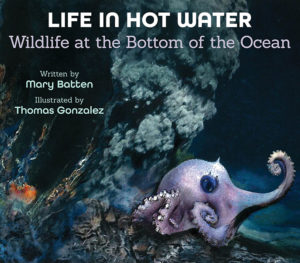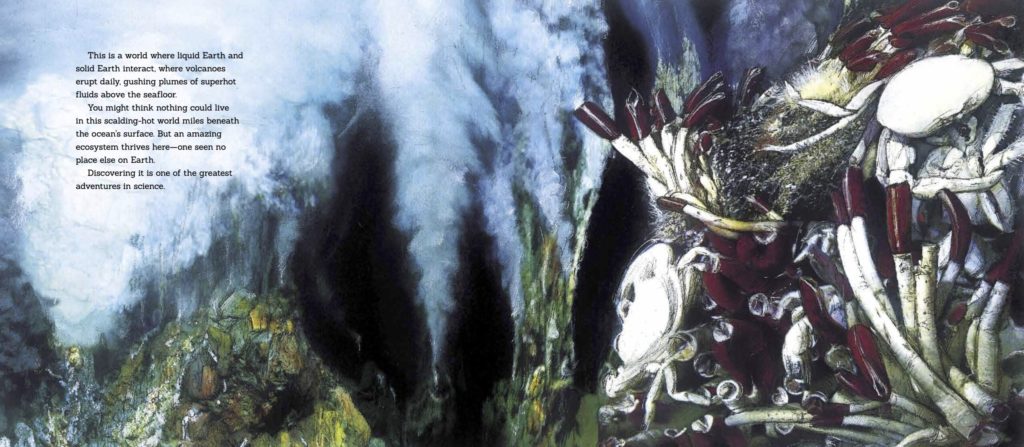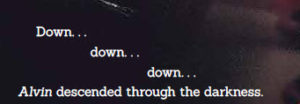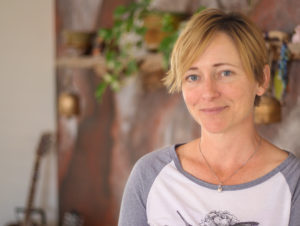
Life in Hot Water: Wildlife at the Bottom of the Ocean
Author: Mary Batten
Illustrator: Thomas Gonzalez
Peachtree
21 June 2022
40 pages
Ryan’s Review of the Writing
Mary Batten’s new picture book, Life in Hot Water: Wildlife at the Bottom of the Ocean, takes readers on a deep dive into one of the most extreme environments on Earth–hydrothermal vents. While a nonfiction look into an environment could easily be bland, Batten works to find beauty both in the subject matter and the language she uses to describe it. For example, phrases like “gushing plumes of superhot fluids” help nature come alive in ways kids might enjoy almost as much as Gonzalez’s evocative illustrations.

Batten also makes use of text placement such as how she describes the descent of a 1997 HOV (human-operated vehicle) called Alvin:

Life in Hot Water helps readers understand that prior to the deep-sea dives where these vent ecosystems were found, people believed that complex ecosystems could only thrive with sunlight and green plants. The basis for all food chains HAD to be photosynthesis. But after seeing life thrive in such a harsh environment without sunlight or green plants, scientists realized how wrong they were. In fact, this AHA moment–finding underwater vent ecosystem that were powered by chemicals inside the Earth–is “one of the most important discoveries of the twentieth century.”
In addition to offering lots of specific scientific facts (the temperatures that vent bacteria could live in, the difference between black smokers and white smokers, how there are 650 vents around the world, etc.), Batten also includes quotations both short and long from a range of scientists to help give voice and character to the discoveries that otherwise might feel didactic.
Kids who like icky or weird things will be drawn to facts such as: “Sharing the snail’s environment are crustaceans called Hoff crabs that have no eyes. They get their food from bacteria living in their chest hairs.” There’s also interesting medicine-focused information such as how an antibiotic has already been made from the Pompeii worm’s bacteria or how the study of a specific enzyme led to the creation of a coronavirus test.
One thing I particularly appreciate is how Batten uses back matter. A book with this much science behind it could easily wax scientific in great length and detail after the main story, but it doesn’t. Readers instead get a readable two-page, 10-point “Learn More About the Deep Open” list along with a lively one-page Author’s Note and a brief Glossary.
This will be a good addition for any school, library, or science lover.
4.5 out of 5 pencils
Bonnie’s Review of the Illustrations
Thomas Gonzalez’s atmospheric illustrations in Life in Hot Water: Wildlife at the Bottom of the Ocean capture a bizarre and seldom seen ecosystem that thrives at extreme depths. Using pastels, colored pencils, and an airbrush, Gonzalez masterfully portrays a craggy sea floor bursting open from rising geothermal steam. A sense of unworldly chaos is expressed through highly textured plumes of gray silt rising like geysers into an inky abyss. Mysterious eyeless alien-like creatures cling to the crusty vents, feeding on nutrients or perhaps each other! Feathery tube worms, blind crabs, and iron-clad gastropods cluster about in one intriguing spread where light shines into the distance, highlighting the blurred ripples of a rising thermocline.
Gonzalez does a great job of handling Mary Batten’s lengthy but fascinating text. He manages to achieve spaciousness even when illustrating hundreds of tube worms piled on top of each other. Each worm moves with the current, directing the viewer’s eye through the spread’s dynamic landscape. In another favorite spread, a lone amphipod floats on a spacious black background, stretching its body toward the life-giving warmth of a nearby hydrothermal vent.
Even when depicting humans inside a submersible or on the deck of a research vessel, Gonzalez stays within his limited color palette and finds ways to continue his use of rich textures and dramatic lighting. Overall, this is a fabulous follow up to Life in a Frozen World: Wildlife of Antarctica and I can’t wait to see the next book in this series. I was the kind of child who would pore over books like these for hours. I know there are many children out there who will also enjoy dipping into this mysterious “hot water” world.
5 out of 5 crayons

Bonnie Kelso is a huge fan of everything ocean. She once dived off the coast of an active volcano and witnessed the awesomeness of CO2 vents up close and personal.
Bonnie’s debut informational fiction picture book Nudi Gill, about a feisty sea slug, releases March 2023 by Gnome Road Publishing. She is currently completing the final illustrations for In a Cave by Heather Kinser, also to be published by Gnome Road Publishing in 2023.
A graduate of the Rhode Island School of Design, Bonnie’s past experience in art spans a spectrum, from abstract painting on canvas to museum-quality exhibit design. She has worked with clients such as the Smithsonian, National Geographic, and NASA.
She lives in Las Vegas with her partner, two sons, and an unruly cat. To learn more about Bonnie’s work, please visit www.BonnieKelso.com.

